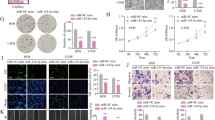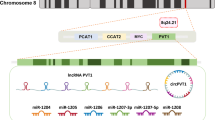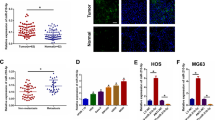Abstract
Osteosarcoma (OS) is considered to be a malignant bone tumour that mainly affects the long bones, but it is also involved in other bones of the body. Currently, surgery and chemotherapy have achieved some response to patients with OS, but they are not increasing the survival rate as well as treatment options. Researchers made lot of drug options for OS, but yet, no treatment is existing in sight for the disease and needs a new insight into the molecular and signaling pathways for the disease. Now, it is necessary to develop a novel and alternative strategy for the prognosis, diagnosis and treatment options for OS. MicroRNAs (miRNAs) are a small non-coding RNA, and their size ranges from 18 to 22 nt in length. In the nucleus, miRNAs originate and transcribe into primary transcripts and later cleaved to produce stem loop-structured precursor nucleotides. microRNA 21 (miR-21) is considered to be a trivial marker for many diseases and has been upregulated in many cancers. Moreover, it plays a main role in proliferation, migration, invasion and apoptosis. miR-21 and its associated pathways are very important and play a critical role in the pathogenesis of OS and are considered to be a biomarker and a therapeutic target for OS. To our knowledge, there is no paper that demonstrates the responsibility and the role of miR-21 in OS and the number of studies related to miR-21 in OS is spare. Therefore, the main aim of this paper is to give an outline of the recent clinical investigation and importance of miR-21 in OS. It has been suggested that the up- and downregulation of miRNAs plays a crucial role in the pathogenesis and progression of OS. Normally, miR-21 was found to be upregulated in OS; however, we summarize the clinical relevance and the recent research findings associated with miR-21 in OS.
This is a preview of subscription content, access via your institution
Access options
Subscribe to this journal
Receive 12 print issues and online access
$259.00 per year
only $21.58 per issue
Buy this article
- Purchase on Springer Link
- Instant access to full article PDF
Prices may be subject to local taxes which are calculated during checkout

Similar content being viewed by others
References
Moore DD, Luu HH. Osteosarcoma. Cancer Treat Res. 2014;162:65–92.
Sampson VB, Yoo S, Kumar A, Vetter NS, Anders Kolb E. MicroRNAs and Potential Targets in Osteosarcoma: Review. Front Pediatr. 2015;3:69.
Mohseny AB, Szuhai K, Romeo S, Buddingh EP, Briaire-de BI, de Jong D, et al. Osteosarcoma originates from mesenchymal stem cells in consequence of aneuploidization and genomic loss of Cdkn2. J Pathol. 2009;219:294–305.
Cheng D, Qiu X, Zhuang M, Zhu C, Zou H, Liu Z. MicroRNAs with prognostic significance in osteosarcoma: a systemic review and meta-analysis. Oncotarget. 2017;8:81062–74.
D Sekar. Comment on the potential role of microRNAs in hypertension. J Hum Hypertens 2018;32:639.
Panagal M, Biruntha M, Vidhyavathi RM, Sivagurunathan P, Senthilkumar SR, Sekar D. Dissecting the role of miR-21 in different types of stroke. Gene. 2019;681:69–72.
Panagal M, S R SK PS, M B, M K, Gopinathe V, et al. MicroRNA21 and the various types of myeloid leukemia. Cancer Gene Ther. 2018;25:161–6.
Priyanka P, Panagal M, Sivakumar P, Gopinath V, Ananthavalli R, Karthigeyan M, et al. Identification, expression, and methylation of miR-7110 and its involvement in type 1 diabetes mellitus. Gene Rep. 2018;11:229–34.
Martin-Guerrero I, Bilbao-Aldaiturriaga N, Gutierrez-Camino A, Santos-Zorrozua B, Dolžan V, Patiño-Garcia A, et al. Variants in the 14q32 miRNA cluster are associated with osteosarcoma risk in the Spanish population. Sci Rep. 2018;8:15414.
Sekar D, Venugopal B, Sekar P, Ramalingam K. Role of microRNA 21 in diabetes and associated/related diseases. Gene. 2016;582:14–8.
Sekar D, Krishnan R, Panagal M, Sivakumar P, Gopinath V, Basam V. Deciphering the role of microRNA 21 in cancer stem cells (CSCs). Genes Dis. 2016;3:277–81.
Shang G, Mi Y, Mei Y, Wang G, Wang Y, Li X, et al. MicroRNA-192 inhibits the proliferation, migration and invasion of osteosarcoma cells and promotes apoptosis by targeting matrix metalloproteinase-11. Oncol Lett. 2018;15:7265–72.
Pan X, Wang Z-X, Wang R. MicroRNA-21: a novel therapeutic target in human cancer. Cancer Biol Ther. 2010;10:1224–32.
Ribas J, Ni X, Castanares M, Liu MM, Esopi D, Yegnasubramanian S, et al. A novel source for miR-21 expression through the alternative polyadenylation ofVMP1 gene transcripts. Nucleic Acids Res. 2012;40:6821–33.
Sekar D, Hairul Islam VI, Thirugnanasambantham K, Saravanan S. Relevance of miR-21 in HIV and non-HIV-related lymphomas. Tumour Biol. 2014;35:8387–93.
Meng F, Henson R, Wehbe-Janek H, Ghoshal K, Jacob ST, Patel T. MicroRNA-21 regulates expression of the PTEN tumor suppressor gene in human hepatocellular cancer. Gastroenterology. 2007;133:647–58.
Zhu S, Si ML, Wu H, Mo YY. MicroRNA-21 targets the tumor suppressor genetropomyosin1 (TPM1). J Biol Chem. 2007;282:14328–36.
Asangani IA, Rasheed SA, Nikolova DA, Leupold JH, Colburn NH, Post S, et al. MicroRNA-21 (miR-21) post-transcriptionally downregulates tumor suppressor Pdcd4 and stimulates invasion, intravasation and metastasis in colorectal cancer. Oncogene. 2008;27:2128–36.
Yu Y, Nangia-Makker P, Farhana L, Rajendra G, Levi S, Majumdar E. AP. miR-21 and miR-145 cooperation in regulation of colon cancer stem cells. Mol Cancer. 2015;14:98.
Zhu KP, Zhang CL, Ma XL, Hu JP, Cai T, Zhang L. Analyzing the Interactions of mRNAs and ncRNAs to Predict Competing Endogenous RNA Networks in Osteosarcoma Chemo-Resistance. Mol Ther. 2019. pii: S1525-0016(19)30002-4.
Heishima K, Meuten T, Yoshida K, Mori T, Thamm DH. Prognostic significance of circulating microRNA-214 and -126 in dogs with appendicular osteosarcoma receiving amputation and chemotherapy. BMC Vet Res. 2019;15:39.
Shekhar R, Priyanka P, Kumar P, Ghosh T, Khan MM, Nagarajan P et al. The microRNAs miR-449a and miR-424 suppress osteosarcoma by targeting cyclin A2 expression. J Biol Chem. 2019. pii: jbc.RA118.005778.
Zhao J, Zhang C, Gao Z, Wu H, Gu R, Jiang R. Long non-coding RNA ASBEL promotes osteosarcoma cell proliferation, migration, and invasion by regulating microRNA-21. J Cell Biochem. 2018;119:6461–9.
Hua Y, Jin Z, Zhou F, Zhang YQ, Zhuang Y. The expression significance of serum MiR-21 in patients with osteosarcoma and its relationship with chemosensitivity. Eur Rev Med Pharmacol Sci. 2017;21:2989–94.
Nakka M, Allen-Rhoades W, Li Y, Kelly AJ, Shen J, Taylor AM, et al. TARGET osteosarcoma consortium. Biomarker significance of plasma and tumor miR-21, miR-221, and miR-106a in osteosarcoma. Oncotarget. 2017;8:96738–52.
Yuan J, Chen L, Chen X, Sun W, Zhou X. Identification of serum microRNA-21 as a biomarker for chemosensitivity and prognosis in human osteosarcoma. J Int Med Res. 2012;40:2090–7.
Ziyan W, Yang L. MicroRNA-21 regulates the sensitivity to cisplatin in a human osteosarcoma cell line. Ir J Med Sci. 2016;185:85–91.
Zhang R, Xia T. Long non-coding RNA XIST regulates PDCD4 expression by interacting with miR-21-5p and inhibits osteosarcoma cell growth and metastasis. Int J Oncol. 2017;51:1460–70.
Yang C, Wang G, Yang J, Wang L. Long noncoding RNA NBAT1 negatively modulates growth and metastasis of osteosarcoma cells through suppression of miR-21. Am J Cancer Res. 2017;7:2009–19.
Heng L, Jia Z, Bai J, Zhang K, Zhu Y, Ma J, et al. Molecular characterization of metastatic osteosarcoma: differentially expressed genes, transcription factors and microRNAs. Mol Med Rep. 2017;15:2829–36.
Xu B, Xia H, Cao J, Wang Z, Yang Y, Lin Y. MicroRNA-21 Inhibits the Apoptosis of Osteosarcoma Cell Line SAOS-2 via Targeting Caspase 8. Oncol Res. 2017;25:1161–8.
Ren X, Shen Y, Zheng S, Liu J, Jiang X. miR-21 predicts poor prognosis in patients with osteosarcoma. Br J Biomed Sci. 2016;73:158–62.
Lv C, Hao Y, Tu G. MicroRNA-21 promotes proliferation, invasion and suppresses apoptosis in human osteosarcoma line MG63 through PTEN/Akt pathway. Tumour Biol. 2016;37:9333–42.
Ouyang L, Liu P, Yang S, Ye S, Xu W, Liu X. A three-plasma miRNA signature serves as novel biomarkers for osteosarcoma. Med Oncol. 2013;30:340.
Trang P, Medina PP, Wiggins JF, Ruffino L, Kelnar K, Omotola M, et al. Regression of murine lung tumors by the let-7 microRNA. Oncogene. 2009;29:1580–7.
Author information
Authors and Affiliations
Corresponding author
Ethics declarations
Conflict of interest
The authors declare that they have no conflict of interest.
Additional information
Publisher’s note: Springer Nature remains neutral with regard to jurisdictional claims in published maps and institutional affiliations.
Rights and permissions
About this article
Cite this article
Sekar, D., Mani, P., Biruntha, M. et al. Dissecting the functional role of microRNA 21 in osteosarcoma. Cancer Gene Ther 26, 179–182 (2019). https://doi.org/10.1038/s41417-019-0092-z
Received:
Revised:
Accepted:
Published:
Issue Date:
DOI: https://doi.org/10.1038/s41417-019-0092-z
This article is cited by
-
Split-DNAzyme cooperating primer exchange reaction for sensitive miRNA detection
Journal of Analytical Science and Technology (2022)
-
c-Myb-mediated inhibition of miR-601 in facilitating malignance of osteosarcoma via augmentation of PKMYT1
Scientific Reports (2022)
-
Coding the noncoding: 2 years of advances in the field of microRNAs and long noncoding RNAs
Cancer Gene Therapy (2021)
-
MiR-455-3p downregulation facilitates cell proliferation and invasion and predicts poor prognosis of osteosarcoma
Journal of Orthopaedic Surgery and Research (2020)



